非谓语动词速记口诀
非谓语动词做题口诀
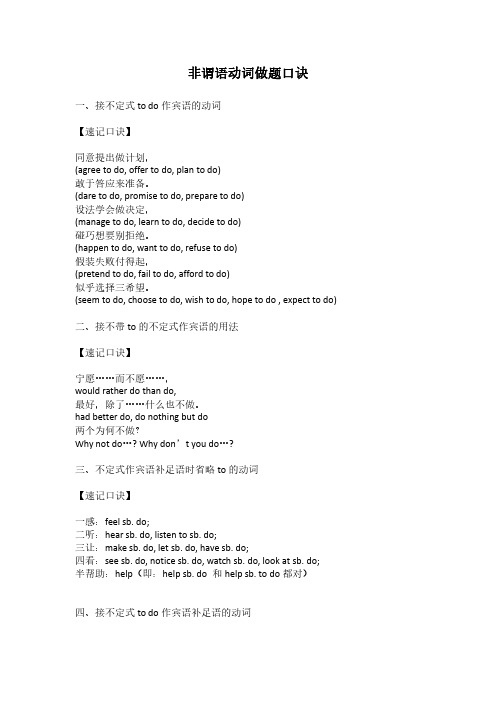
非谓语动词做题口诀
一、接不定式to do作宾语的动词
【速记口诀】
同意提出做计划,
(agree to do,offer to do,plan to do)
敢于答应来准备。
(dare to do,promise to do,prepare to do)
设法学会做决定,
(manage to do,learn to do,decide to do)
碰巧想要别拒绝。
(happen to do,want to do,refuse to do)
假装失败付得起,
(pretend to do,fail to do,afford to do)
似乎选择三希望。
(seem to do,choose to do,wish to do,hope to do,expect to do)二、接不带to的不定式作宾语的用法
【速记口诀】
宁愿……而不愿……,
would rather do than do,
最好,除了……什么也不做。
had better do,do nothing but do
两个为何不做?
Why not do…?Why don’t you do…?
三、不定式作宾语补足语时省略to的动词
【速记口诀】
一感:feel sb.do;
二听:hear sb.do,listen to sb.do;
三让:make sb.do,let sb.do,have sb.do;
四看:see sb.do,notice sb.do,watch sb.do,look at sb.do;
半帮助:help(即:help sb.do和help sb.to do都对)
非谓语动词口诀(整理版)

只能接-ing作宾语的动词口诀:
喜欢花费忙着想象忍不住想要结束练习enjoy doing sth. 喜欢做某事spend...doing sth. 花费…做某事
be busy doing sth. 忙于做…
imagine sb. doing sth. 想象…做某事
can't help doing sth. 忍不住做某事
feel like doing sth. 想要做某事
finish doing sth. 完成做某事practice doing sth. 练习做某事
错过建议保持介意值得考虑
miss doing sth. 错过做某事suggest doing sth. 建议做某事
keep (on) doing sth. 保持(继续)做某事mind doing sth. 介意做某事
be worth doing sth. 值得做某事
介词+doing
be good at doing sth擅长做某事
be interested in doing sth. 对做某事感兴趣insist on doing 坚持做某事
be used for doing sth. 被用来做某事thank sb. for doing sth. 谢谢某人做某事be tired of doing sth. 厌烦做某事
be afraid of doing sth. 害怕做某事
put off doing 推迟做某事
stop sb. from doing sth. 阻止某人做某事give up doing sth. 放弃做某事without doing sth. 没有做某事think about doing sth. 考虑做某事What ∕ How about doing 做某事怎么样?
(完整版)高考非谓语动词口诀打印版
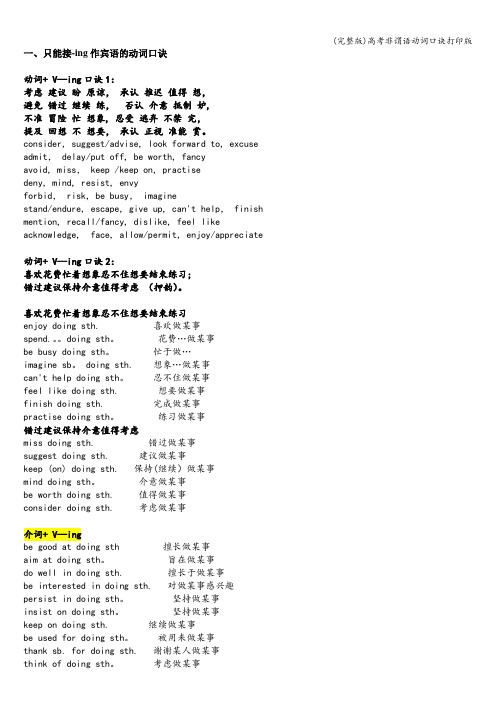
一、只能接-ing作宾语的动词口诀
动词+ V—ing口诀1:
考虑建议盼原谅,承认推迟值得想,
避免错过继续练,否认介意抵制妒,
不准冒险忙想象, 忍受逃弃不禁完,
提及回想不想要,承认正视准能赏。
consider, suggest/advise, look forward to, excuse admit, delay/put off, be worth, fancy
avoid, miss, keep /keep on, practise
deny, mind, resist, envy
forbid, risk, be busy, imagine
stand/endure, escape, give up, can't help, finish mention, recall/fancy, dislike, feel like acknowledge, face, allow/permit, enjoy/appreciate
动词+ V—ing口诀2:
喜欢花费忙着想象忍不住想要结束练习;
错过建议保持介意值得考虑(押韵)。
喜欢花费忙着想象忍不住想要结束练习
enjoy doing sth. 喜欢做某事
spend.。。doing sth。花费…做某事
be busy doing sth。忙于做…
imagine sb。 doing sth. 想象…做某事
can't help doing sth。忍不住做某事
feel like doing sth. 想要做某事
finish doing sth. 完成做某事
非谓语动词口诀
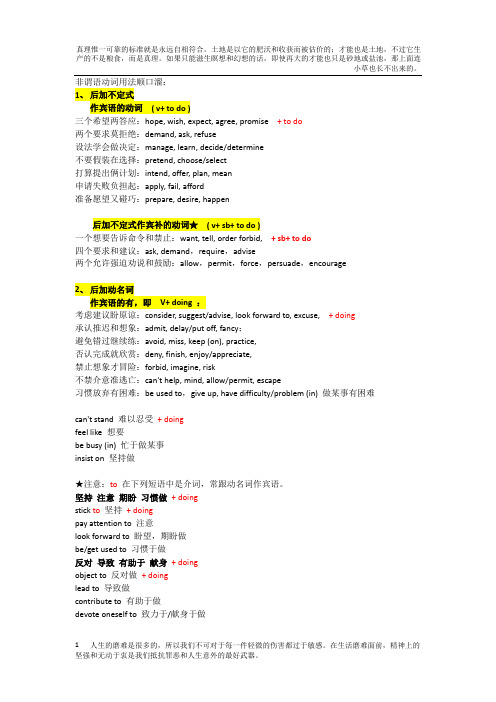
非谓语动词用法顺口溜:
1、后加不定式
作宾语的动词( v+ to do )
三个希望两答应:hope, wish, expect, agree, promise + to do
两个要求莫拒绝:demand, ask, refuse
设法学会做决定:manage, learn, decide/determine
不要假装在选择:pretend, choose/select
打算提出俩计划:intend, offer, plan, mean
申请失败负担起:apply, fail, afford
准备愿望又碰巧:prepare, desire, happen
后加不定式作宾补的动词★( v+ sb+ to do )
一个想要告诉命令和禁止:want, tell, order forbid, + sb+ to do
四个要求和建议:ask, demand,require,advise
两个允许强迫劝说和鼓励:allow,permit,force,persuade,encourage
2、后加动名词
作宾语的有,即V+ doing :
考虑建议盼原谅:consider, suggest/advise, look forward to, excuse, + doing
承认推迟和想象:admit, delay/put off, fancy;
避免错过继续练:avoid, miss, keep (on), practice,
否认完成就欣赏:deny, finish, enjoy/appreciate,
禁止想象才冒险:forbid, imagine, risk
英语非谓语口诀
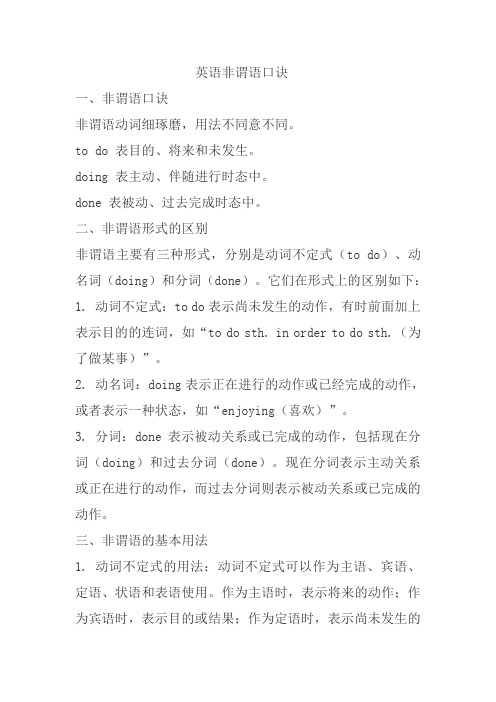
英语非谓语口诀
一、非谓语口诀
非谓语动词细琢磨,用法不同意不同。
to do 表目的、将来和未发生。
doing 表主动、伴随进行时态中。
done 表被动、过去完成时态中。
二、非谓语形式的区别
非谓语主要有三种形式,分别是动词不定式(to do)、动名词(doing)和分词(done)。它们在形式上的区别如下:1. 动词不定式:to do表示尚未发生的动作,有时前面加上表示目的的连词,如“to do sth. in order to do sth.(为了做某事)”。
2. 动名词:doing表示正在进行的动作或已经完成的动作,或者表示一种状态,如“enjoying(喜欢)”。
3. 分词:done表示被动关系或已完成的动作,包括现在分词(doing)和过去分词(done)。现在分词表示主动关系或正在进行的动作,而过去分词则表示被动关系或已完成的动作。
三、非谓语的基本用法
1. 动词不定式的用法:动词不定式可以作为主语、宾语、定语、状语和表语使用。作为主语时,表示将来的动作;作为宾语时,表示目的或结果;作为定语时,表示尚未发生的
动作;作为状语时,表示目的或结果;作为表语时,表示主语的意图或愿望。
2. 动名词的用法:动名词可以作为主语、宾语、定语和表语使用。作为主语时,表示泛指或抽象动作;作为宾语时,表示正在进行的动作或状态;作为定语时,表示正在进行的动作或状态;作为表语时,表示主语的性质或特征。
3. 分词的用法:分词可以作为定语、状语和表语使用。作为定语时,表示被动关系或已完成的动作;作为状语时,表示正在进行的动作或状态;作为表语时,表示主语的性质或特征。
英语语法非谓语动词口诀整理版
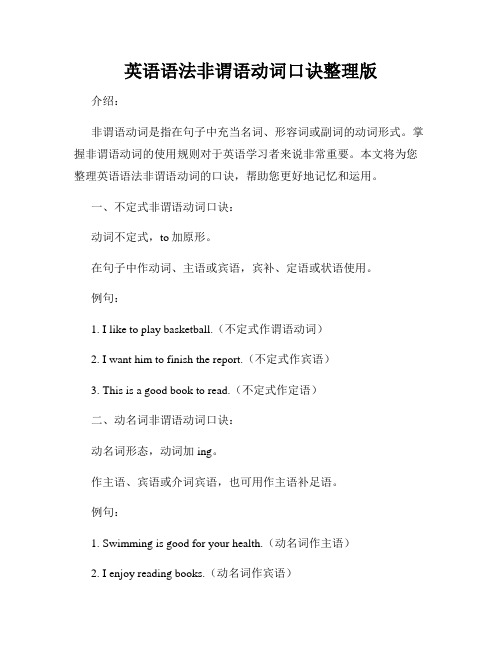
英语语法非谓语动词口诀整理版介绍:
非谓语动词是指在句子中充当名词、形容词或副词的动词形式。掌握非谓语动词的使用规则对于英语学习者来说非常重要。本文将为您整理英语语法非谓语动词的口诀,帮助您更好地记忆和运用。
一、不定式非谓语动词口诀:
动词不定式,to加原形。
在句子中作动词、主语或宾语,宾补、定语或状语使用。
例句:
1. I like to play basketball.(不定式作谓语动词)
2. I want him to finish the report.(不定式作宾语)
3. This is a good book to read.(不定式作定语)
二、动名词非谓语动词口诀:
动名词形态,动词加ing。
作主语、宾语或介词宾语,也可用作主语补足语。
例句:
1. Swimming is good for your health.(动名词作主语)
2. I enjoy reading books.(动名词作宾语)
3. She is interested in learning French.(动名词作介词宾语)
三、过去分词非谓语动词口诀:
过去分词表被动,辅助动词辅助上。
常与情态动词连用,表示完成或被动。
例句:
1. The book was written by Mark Twain.(过去分词作谓语动词)
2. The window was broken by the ball.(过去分词作宾语)
四、不定式与动名词非谓语动词口诀:
非谓语动词,变换形态。
动词不定式to加原形,动名词改成ing。
例句:
非谓语动词口诀版

不定式:to+动词原形 动名词:动词原形+ing 分词(现在分词和过去分词)
考点分析
非谓语动词是每年中考的必考内容 主要集中在对动词不定式和动名词的考查
动名词: doing 动词不定式: to do
动名词
动词+doing doing
介词+doing
喜欢花费忙着想象忍不住想要结束练习
-______. Please do it.
A. to open; OK
B. opening; Certainly not
C. opening; Of course
D. to open; Good idea
3. No matter how hard it is, we'll keep_____until we make it.
区分下列词组:
see sb. doing/ do sth. hear sb. doing/ do sth. watch sb. doing/ do sth. notice sb. doing/ do sth.
感官动词 see, watch, look at, notice, hear, listen to, feel
A.dancing B. to dance C. dances D. dance
4.Let’s ______swimming after the exam .
非谓语动词口诀(大全)

非谓语动词口诀(大全)
一、选择题
1.(2017届山东省滨州市滨城区九年级第二次模拟)David enjoys ____ music at weekends, but I prefer ________ for a picnic.
A.listening to;go out B.listening to;to go out
C.to listen to;to go out D.listen to;going out
2.It took us one week ________ this article ________ by Mo Yan.
A.read, written B.to read, written C.reading, to write D.to read, to write 3.— Jack, why have you decided ________ Chinese folk music as a course.
— To learn more about Chinese culture.
A.take B.taken C.to take D.taking 4.Spending the holiday in nearby places has become a trend this year as local governments encourage people ________ too far.
A.travelling B.not travelling C.travel D.not to travel 5.Don’t forget ________ the door when you leave here.
非谓语动词用法口诀
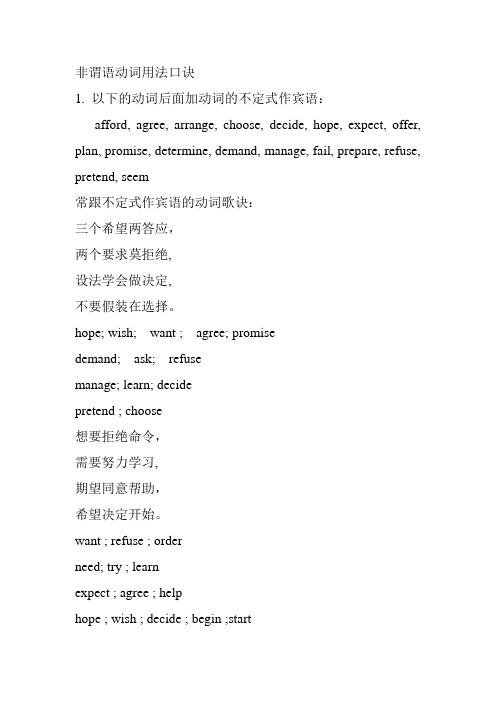
非谓语动词用法口诀
1. 以下的动词后面加动词的不定式作宾语:
afford, agree, arrange, choose, decide, hope, expect, offer, plan, promise, determine, demand, manage, fail, prepare, refuse, pretend, seem
常跟不定式作宾语的动词歌诀:
三个希望两答应,
两个要求莫拒绝,
设法学会做决定,
不要假装在选择。
hope; wish; want ; agree; promise
demand; ask; refuse
manage; learn; decide
pretend ; choose
想要拒绝命令,
需要努力学习,
期望同意帮助,
希望决定开始。
want ; refuse ; order
need; try ; learn
expect ; agree ; help
hope ; wish ; decide ; begin ;start
2.以下的动词后面加动词的ing作宾语:
admit, advise, allow, appreciate, avoid, complete, consider, delay, deny, enjoy, escape, finish, imagine, keep, mind, miss, practise, suggest, stop, can’t stand, can’t help, be worth
常跟动词ing作宾语的动词歌诀:
考虑建议盼原谅,
英语语法非谓语动词口诀整理版
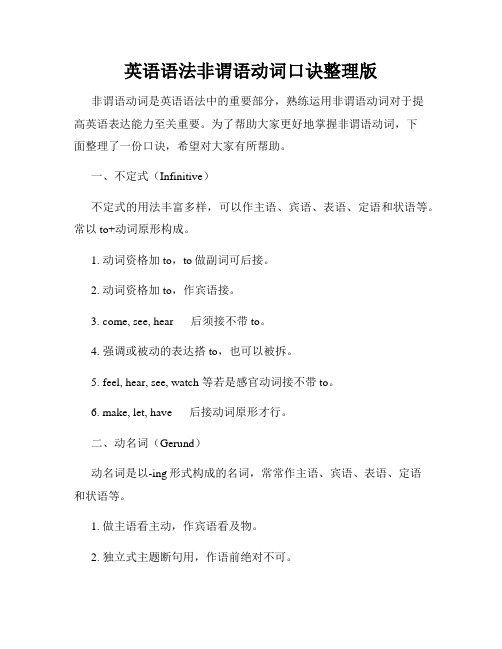
英语语法非谓语动词口诀整理版非谓语动词是英语语法中的重要部分,熟练运用非谓语动词对于提
高英语表达能力至关重要。为了帮助大家更好地掌握非谓语动词,下
面整理了一份口诀,希望对大家有所帮助。
一、不定式(Infinitive)
不定式的用法丰富多样,可以作主语、宾语、表语、定语和状语等。常以to+动词原形构成。
1. 动词资格加to,to做副词可后接。
2. 动词资格加to,作宾语接。
3. come, see, hear 后须接不带to。
4. 强调或被动的表达搭to,也可以被拆。
5. feel, hear, see, watch 等若是感官动词接不带to。
6. make, let, have 后接动词原形才行。
二、动名词(Gerund)
动名词是以-ing形式构成的名词,常常作主语、宾语、表语、定语
和状语等。
1. 做主语看主动,作宾语看及物。
2. 独立式主题断句用,作语前绝对不可。
3. 后接复合词不可减,但是也有例外情。
三、现在分词(Present Participle)
现在分词以-ing形式构成,常作定语、表语和状语等。
1. 谓语动作进行中。
2. 构成进行形式,读/si/也正确。
3. 主动语态用作定语。
4. 名词或代词由其修。
四、过去分词(Past Participle)
过去分词常用于完成时态和被动语态,也可用作定语。
1. 构成完成式,没动作将过去加。
2. 被(get, be, become)加短语。
3. 动词带ed成完成时;
若出现irregular变否定、疑问、完成集不要忘。
4. 作定语方式灵活用,修饰名词用一套。
非谓语动词用法速记口诀
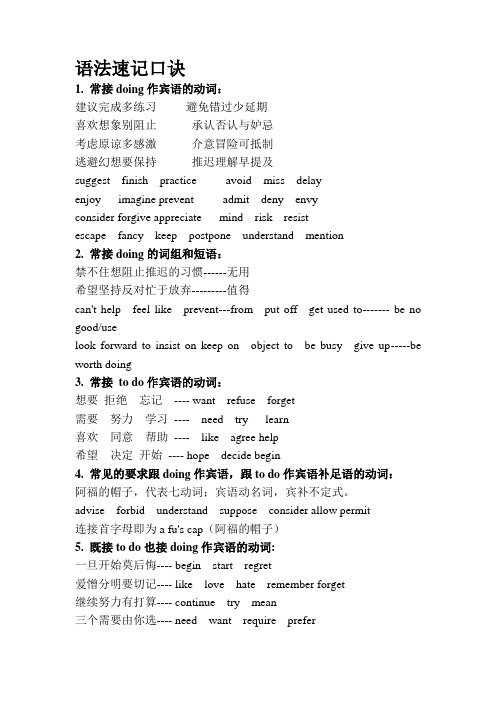
语法速记口诀
1. 常接doing作宾语的动词:
建议完成多练习避免错过少延期
喜欢想象别阻止承认否认与妒忌
考虑原谅多感激介意冒险可抵制
逃避幻想要保持推迟理解早提及
suggest finish practice avoid miss delay
enjoy imagine prevent admit deny envy
consider forgive appreciate mind risk resist
escape fancy keep postpone understand mention
2. 常接doing的词组和短语:
禁不住想阻止推迟的习惯------无用
希望坚持反对忙于放弃---------值得
can't help feel like prevent---from put off get used to------- be no good/use
look forward to insist on keep on object to be busy give up-----be worth doing
3. 常接to do作宾语的动词:
想要拒绝忘记---- want refuse forget
需要努力学习---- need try learn
喜欢同意帮助---- like agree help
希望决定开始---- hope decide begin
4. 常见的要求跟doing作宾语,跟to do作宾语补足语的动词:
阿福的帽子,代表七动词;宾语动名词,宾补不定式。
advise forbid understand suppose consider allow permit
非谓语动词记忆口诀有哪些
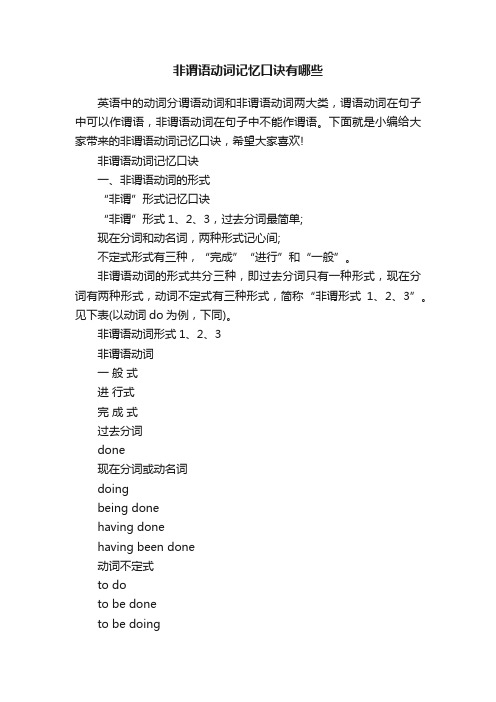
非谓语动词记忆口诀有哪些
英语中的动词分谓语动词和非谓语动词两大类,谓语动词在句子中可以作谓语,非谓语动词在句子中不能作谓语。下面就是小编给大家带来的非谓语动词记忆口诀,希望大家喜欢!
非谓语动词记忆口诀
一、非谓语动词的形式
“非谓”形式记忆口诀
“非谓”形式1、2、3,过去分词最简单;
现在分词和动名词,两种形式记心间;
不定式形式有三种,“完成”“进行”和“一般”。
非谓语动词的形式共分三种,即过去分词只有一种形式,现在分词有两种形式,动词不定式有三种形式,简称“非谓形式1、2、3”。见下表(以动词do为例,下同)。
非谓语动词形式1、2、3
非谓语动词
一般式
进行式
完成式
过去分词
done
现在分词或动名词
doing
being done
having done
having been done
动词不定式
to do
to be done
to be doing
to have done
to have been done
从上表格中可以看出过去分词最简单,只有一种形式,即一般式done,现在分词分一般和完成两种形式,动词不定式有一般式、进行式和完成式三种形式。熟记这些形式,是学好和用好非谓语动词的必要前提,必须在“熟”字上下功夫。当我们在学习和使用非谓语动词时,大脑中首先浮现出“非谓语动词形式1、2、3”这幅图表,答题就有了较好的基础。
二、非谓语动词的功能
非谓语动词总共有10种形式,每种形式用法均不同,不仅如此,有些非谓语动词的不同形式在句子中还可以充当同一功能(比如过去分词、现在分词和不定式均可在句中做定语),但存在区别。以下表格(图2)仅介绍非谓语动词10种形式的主要功能及特点,详细用法可参看有关语法书籍。
非谓语动词口诀(整理版)
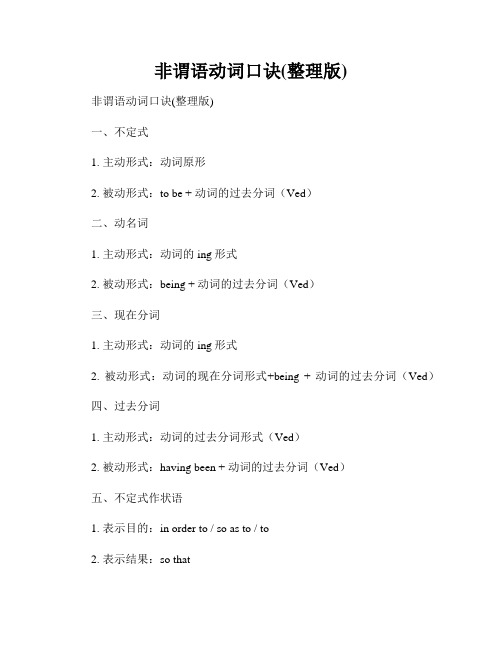
非谓语动词口诀(整理版)
非谓语动词口诀(整理版)
一、不定式
1. 主动形式:动词原形
2. 被动形式:to be + 动词的过去分词(Ved)
二、动名词
1. 主动形式:动词的ing形式
2. 被动形式:being + 动词的过去分词(Ved)
三、现在分词
1. 主动形式:动词的ing形式
2. 被动形式:动词的现在分词形式+being + 动词的过去分词(Ved)
四、过去分词
1. 主动形式:动词的过去分词形式(Ved)
2. 被动形式:having been + 动词的过去分词(Ved)
五、不定式作状语
1. 表示目的:in order to / so as to / to
2. 表示结果:so that
3. 表示原因:for / to / in order to / so as to
4. 表示方式:by / by + 动词的ing形式
5. 表示条件:if / provided (that) / unless
六、非谓语动词作主语
1. 不定式:to do
2. 动名词:doing
3. 现在分词:doing
4. 过去分词:done
七、非谓语动词作宾语
1. 不定式:动词原形
2. 动名词:动词的ing形式
3. 现在分词:动词的ing形式
4. 过去分词:动词的过去分词形式(Ved)
八、非谓语动词作定语
1. 不定式:to do
2. 动名词:doing
3. 现在分词:doing
4. 过去分词:done
九、非谓语动词作表语
1. 不定式:be + 不定式
2. 动名词:be + 动词的ing形式
3. 现在分词:be + 动词的ing形式
非谓语动词口诀
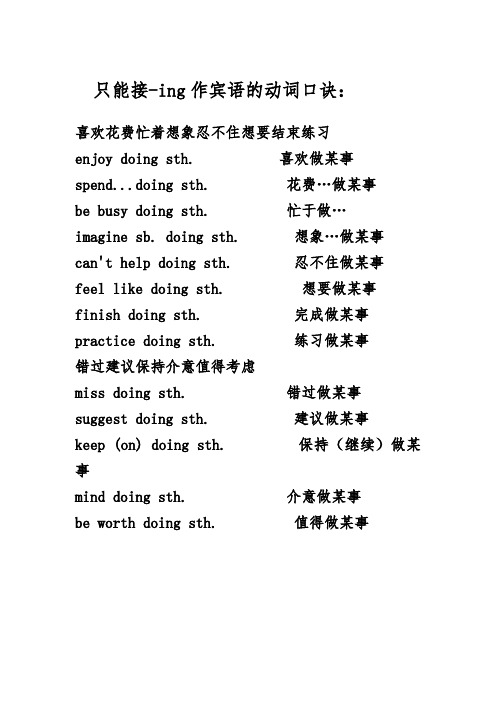
只能接-ing作宾语的动词口诀:
喜欢花费忙着想象忍不住想要结束练习
enjoy doing sth. 喜欢做某事spend...doing sth. 花费…做某事
be busy doing sth. 忙于做… imagine sb. doing sth. 想象…做某事
can't help doing sth. 忍不住做某事
feel like doing sth. 想要做某事
finish doing sth. 完成做某事practice doing sth. 练习做某事
错过建议保持介意值得考虑
miss doing sth. 错过做某事suggest doing sth. 建议做某事
keep (on) doing sth. 保持(继续)做某事
mind doing sth. 介意做某事
be worth doing sth. 值得做某事
介词+doing
be good at doing sth 擅长做某事
be interested in doing sth. 对做某事感兴趣
insist on doing 坚持做某事
be used for doing sth. 被用来做某事thank sb. for doing sth. 某人做某事
be tired of doing sth. 厌烦做某事
be afraid of doing sth. 害怕做某事put off doing 推迟做某事
stop sb. from doing sth. 阻止某人做某事
give up doing sth. 放弃做某事without doing sth. 没有做某事
非谓语动词口诀(速记重点)
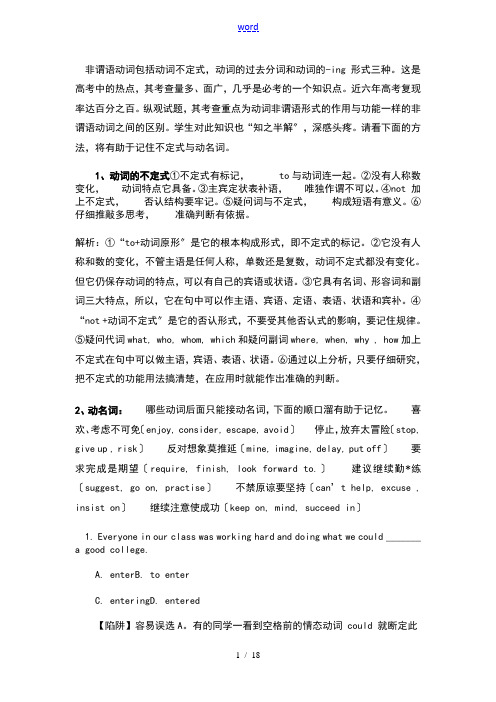
非谓语动词包括动词不定式,动词的过去分词和动词的-ing形式三种。这是高考中的热点,其考查量多、面广,几乎是必考的一个知识点。近六年高考复现率达百分之百。纵观试题,其考查重点为动词非谓语形式的作用与功能一样的非谓语动词之间的区别。学生对此知识也“知之半解〞,深感头疼。请看下面的方法,将有助于记住不定式与动名词。
1、动词的不定式①不定式有标记,to与动词连一起。②没有人称数变化,动词特点它具备。③主宾定状表补语,唯独作谓不可以。④not 加上不定式,否认结构要牢记。⑤疑问词与不定式,构成短语有意义。⑥仔细推敲多思考,准确判断有依据。
解析:①“to+动词原形〞是它的根本构成形式,即不定式的标记。②它没有人称和数的变化,不管主语是任何人称,单数还是复数,动词不定式都没有变化。但它仍保存动词的特点,可以有自己的宾语或状语。③它具有名词、形容词和副词三大特点,所以,它在句中可以作主语、宾语、定语、表语、状语和宾补。④“not +动词不定式〞是它的否认形式,不要受其他否认式的影响,要记住规律。
⑤疑问代词what, who, whom, which和疑问副词where, when, why , how加上不定式在句中可以做主语,宾语、表语、状语。⑥通过以上分析,只要仔细研究,把不定式的功能用法搞清楚,在应用时就能作出准确的判断。
2、动名词:哪些动词后面只能接动名词,下面的顺口溜有助于记忆。喜欢、考虑不可免〔enjoy, consider, escape, avoid〕停止,放弃太冒险〔stop, give up , risk〕反对想象莫推延〔mine, imagine, delay, put off〕要求完成是期望〔require, finish, look forward to.〕建议继续勤*练〔suggest, go on, practise〕不禁原谅要坚持〔can’t help, excuse , insist on〕继续注意使成功〔keep on, mind, succeed in〕
非谓语动词英语语法易记口诀
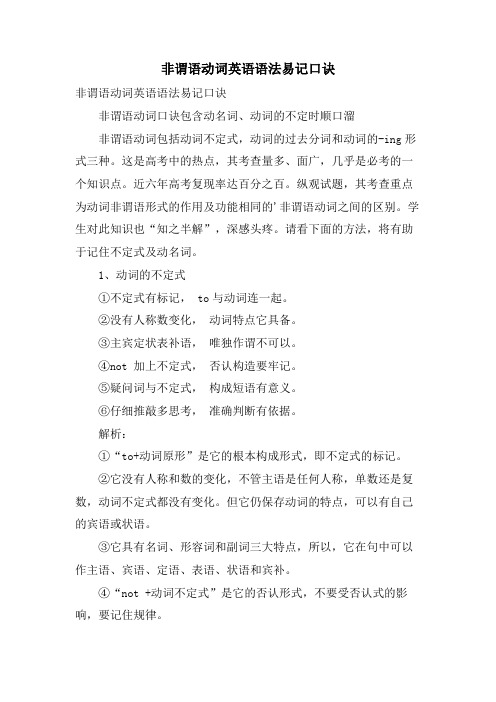
非谓语动词英语语法易记口诀
非谓语动词英语语法易记口诀
非谓语动词口诀包含动名词、动词的不定时顺口溜
非谓语动词包括动词不定式,动词的过去分词和动词的-ing形式三种。这是高考中的热点,其考查量多、面广,几乎是必考的一个知识点。近六年高考复现率达百分之百。纵观试题,其考查重点为动词非谓语形式的作用及功能相同的'非谓语动词之间的区别。学生对此知识也“知之半解”,深感头疼。请看下面的方法,将有助于记住不定式及动名词。
1、动词的不定式
①不定式有标记, to与动词连一起。
②没有人称数变化,动词特点它具备。
③主宾定状表补语,唯独作谓不可以。
④not 加上不定式,否认构造要牢记。
⑤疑问词与不定式,构成短语有意义。
⑥仔细推敲多思考,准确判断有依据。
解析:
①“to+动词原形”是它的根本构成形式,即不定式的标记。
②它没有人称和数的变化,不管主语是任何人称,单数还是复数,动词不定式都没有变化。但它仍保存动词的特点,可以有自己的宾语或状语。
③它具有名词、形容词和副词三大特点,所以,它在句中可以作主语、宾语、定语、表语、状语和宾补。
④“not +动词不定式”是它的否认形式,不要受否认式的影响,要记住规律。
⑤疑问代词what, who, whom, which和疑问副词where, when, why , how加上不定式在句中可以做主语,宾语、表语、状语。
⑥通过以上分析,只要仔细研究,把不定式的功能用法搞清
楚,在应用时就能作出准确的判断。
2、动名词:
哪些动词后面只能接动名词,下面的顺口溜有助于记忆。
喜欢、考虑不可免(enjoy, consider, escape, avoid)
- 1、下载文档前请自行甄别文档内容的完整性,平台不提供额外的编辑、内容补充、找答案等附加服务。
- 2、"仅部分预览"的文档,不可在线预览部分如存在完整性等问题,可反馈申请退款(可完整预览的文档不适用该条件!)。
- 3、如文档侵犯您的权益,请联系客服反馈,我们会尽快为您处理(人工客服工作时间:9:00-18:30)。
1.只能接-ing作宾语的动词口诀:
喜欢花费忙着想象忍不住想要结束练习
enjoy doing sth. 喜欢做某事 spend...doing sth. 花费…做某事
be busy doing sth. 忙于做… imagine sb. doing sth. 想象…做某事
can't help doing sth. 忍不住做某事 feel like doing sth. 想要做某事
finish doing sth. 完成做某事 practice doing sth. 练习做某事
错过建议保持介意值得考虑
miss doing sth. 错过做某事 suggest doing sth. 建议做某事
keep (on) doing sth. 保持(继续)做某事 mind doing sth. 介意做某事
be worth doing sth. 值得做某事
2.介词+doing
be good at doing sth擅长做某事 be interested in doing sth. 对做某事感兴趣insist on doing 坚持做某事 be used for doing sth. 被用来做某事thank sb. for doing sth. 谢谢某人做某事 be tired of doing sth. 厌烦做某事be afraid of doing sth. 害怕做某事 put off doing 推迟做某事
stop sb. from doing sth. 阻止某人做某事 give up doing sth. 放弃做某事without doing sth. 没有做某事 think about doing sth. 考虑做某事What ∕ How about doing 做某事怎么样?
3.此to 非彼to
look forward to doing sth. (盼望) pay attention to doing sth. (注意)
be used to doing sth. (习惯于) prefer doing sth to doing sth.(更喜欢)devote to doing sth(致力于) make a contribution to doing (做贡献)
4.只能接不定式作宾语的动词口诀:
决定想做计划需要同意,能做被用来做的事
decide to do sth. 决定做某事 want ∕ would like to do sth. 想做某事plan to do sth. 计划做某 need to do sth. 需要做某事agree to do sth. 同意做某事 afford to do 能做某事
be used to do 被用来做
迫不及待下决心做过去常常未能做的事
can’t wait to do 迫不及待地要做某事 make up one’s mind to do 下决心做某事used to do过去常常做某事 fail to do 未能做某事
5.接不定式作宾语补足语的动词口诀:
请求与命令
ask sb. to do sth. 请求某人做某事 tell sb. to do sth. 命令某人做某事
想要邀请期待鼓励与建议
want sb. to do sth. 想要某人做某事 invite sb. to do sth. 邀请某人做某事expect sb. to do sth. 期待某人做某事 encourage sb. to do sth. 鼓励某人做某事advise sb. to do sth. 建议某人做某事
答应告诫允许提醒和帮助
promise sb. to do 答应某人做某事 warn sb. not to do sth. 告诫某人做某事allow sb. to do sth. 允许某人做某事 remind sb. to do sth. 提醒某人做某事help sb. (to) do sth. 帮助某人做某事
6.省略to的情况:
使役动词和感官动词后:
一感二听三让四看 feel/ hear, listen to/ let,make, have, / look at, see, watch, notice
had better (not)do sth. 最好(不)做… why not /why don’t you do sth为什么不做…?
help sb.(to)do sth Would rather宁愿做… would you please 情态动词+do 助动词+do
感官动词see, watch, look at, notice, hear, listen to, feel
+ do表示动作的全过程,强调做过这件事或单纯说明谁在干
+doing 表示动作不是全过程,强调正在做某事,指看见的一瞬间某人正在做
注意:被动语态中不能省去to。
stop to do 停下来去做另一件事, stop doing 停止正在做的某事。
forget to do 忘记要去做某事, forget doing 忘记做过某事。
remember to do 记得去做某事 remember doing 记得做过某事
try to do sth. 努力, 尽力做某事 try doing sth. 试着做某事
go on to do做了一件事后,接着做另一件事, go on doing 继续做原来做的事
7.“七给”一“带”to不少,“买”画“制作”for来了。
说明:
(1)、“七给”(give, pass, lend, write, show, send, hand)和“带”(bring)8个及物动词,在直接宾语前置时,必须在后面加上“to”。即“vt. + sth. + to + sb.”如:He lent some money to me.类似动词的还有:get,mail,offer,owe(借),pay,promise,read,sell,take,teach,等(是谁?刚拍了我,好吧!!)
(2)、“buy”(买);“draw”(画);“make”(制作)三个动词,在直接宾语前置时,则必须在后边加“for”,构成“vt. + sth. + for + sb.”。如:Mother bought a new dress for me。类似的动词还有:
build,choose,cook,cut,do,find,fix,leave,order(订购),reach等。
(3)、当直接宾语是代词时,间接宾语for和to于直接宾语之后
Richard made it for him。理查德为他做的这个东西
Give it to me。把它给我
